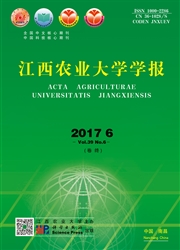

 中文摘要:
中文摘要:
揭示不同双季早稻品种冠层温度的差异及其与产量的关系对早稻耐热品种选育和耐热栽培具有重要意义。研究设置3个施氮量水平(分别为0,120,180 kg/hm2),采用红外线测温仪在孕穗期、抽穗期和灌浆期监测了10个早稻品种冠层温度的差异。结果表明,冠层温度随施氮量的增加而降低。品种间冠层温度的差异随生育期和氮肥用量的变化而变化。聚类分析表明,陆两优996在不同施氮量下冠层温度均最低,属于低温型品种;而赣早籼2号冠层温度均最高,属于高温型品种。在不同氮肥用量下,各生育期气冠温差与产量均呈显著的正相关关系,结实率也表现出同样的趋势。无氮处理下,气冠温差与剑叶长度呈显著正相关。气冠温差与顶三叶叶角呈负相关关系。不同氮肥用量下,冠层温度与抽穗期群体的透光率均呈显著的正相关关系。
 英文摘要:
英文摘要:
Examining the genetic difference in canopy temperature of different early-rice varieties and its relationship with yield is of great importance for increasing crop tolerance to heat stress through crop breeding and cultivation.The present study determined the difference in canopy temperature of ten early-rice varieties using an infrared thermometer under three nitrogen application rates (0,120,180 kghm2) at the booting,heading,and grain-filling stages. The results showed that canopy temperature decreased with increasing nitrogen rates.Interspecific differences in canopy temperature varied with growth stages and nitrogen rates.Cluster analyses indicated that Luliangyou 996 had the lowest canopy temperature,regardless of N rates,and thus could be regarded as the low-temperature type,whereas Ganzaoxian2 consistently had the highest canopy temperature and was classified as the high-temperature type. Canopy temperature depression and the percentage of filled grains were significantly positively correlated with rice yield,regardless of growth stages and nitrogen rates.Canopy temperature depression was significantly positively correlated with the length of flag leaf under no nitrogen treatment,but showed a negative correlation with the angle of the top three leaves.Canopy temperature was significantly positively correlated with light transmittance at the heading stage,regardless of nitrogen rates.
 同期刊论文项目
同期刊论文项目
 同项目期刊论文
同项目期刊论文
 期刊信息
期刊信息
